IDP News Issue No. 19
Secrets of the Tangut Manuscripts
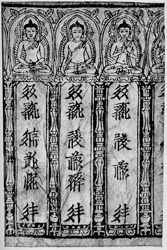
Left:Tangut printed document, now held in the National Museum, New Delhi. Photograph from Innermost Asia, Vol.III, Plate LXV.
Dr Ksenia Kepping is one of a handful of Tangut scholars worldwide and, based in St. Petersburg, she has had the chance to work closely on the largest hoard of Tangut manuscripts, excavated in the early 20th century from a stupa outside the city walls of Kharakhoto and now held in the Institute of Oriental Studies, St. Petersburg branch of the Russian Academy of Sciences (see IDP News 2). In March 2001 Dr Kepping came to London at the invitation of IDP and funded by the UK Heritage Lottery Fund to continue work on the smaller collection of manuscripts acquired from the same site by M. Aurel Stein and held in the British Library.
From her work on the documents Dr Kepping has found evidence to support several interesting and provocative theories— one involving the manner of Chinggis Khan's death. She gave a lecture on this at the Circle of Inner Asian Art and Archaeology in London in May and it will be published in a forthcoming CIAA book (see p. 7). Another document from the St. Petersburg collection contains, Dr Kepping argues, a reference to Chinghis Khan and her article about this is published below. Her work on the London collection has also been very productive and she plans to produce another piece shortly concerning a Buddhist poem.
Conservation work continues on the material at the British Library and IDP has started a programme of digitisation. Over 200 documents are now available (search database for 'Tangut' and 'digitised') and Dr Kepping's work on these along with transcriptions will be added next year. It is hoped that this will encourage a new generation of scholars to become interested in the Tanguts and their rich history and culture.
Chinggis Khan's Name Encrypted in a Tangut Song
Chinggis Khan's last campaign against the Tanguts (1226-7) proved to be fatal to both sides. Legend tells how the Great Khan met his death on Tangut territory in August 1227, and this same year is regarded as that of the total destruction of the Tangut state (982-1227) at the hands of the Mongols. The sources used to support this hypothesis, however, although written in several languages, do not include Tangut material. All Tangut historical records are believed to have been destroyed during the Mongolian invasion as there are no extant texts. This is why the mention of Chinggis Khan's name in one of the Tangut ritual songs (tentatively I date it to the beginning of the 14th century) at first seemed to me unbelievable.
The wood-block print (Tang.25, No 121) held in the Kozlov collection, St. Petersburg, contains five Tangut odes written partly in Tangut ritual language.1 On the verso are 30 or so Tangut ritual songs in cursive hand-writing, in parts almost illegible.
The colophon on the recto states that the woodblock was cut in 1185-6, to wit, in the reign of Renzong, Weiming Renxiao (r.1139-93), the golden age of the Tangut Empire. I would argue that the ritual songs on the verso are obviously written later and certainly not before the beginning of the 14th century since the song under discussion here mentions 'Phags-pa's death: this only took place in 1280.
The content of the printed odes shows that they have nothing to do with Buddhism (there is not a single word specifically from Buddhist vocabulary). In my opinion, the odes convey ancient Tangut ideas about their origins and shamanistic beliefs and were compiled long before the founding of the Tangut state (although they were only transcribed later).
In contrast, the ritual songs on the verso are permeated with Buddhist ideas. I believe they represent secret Tantric knowledge usually transmitted orally from teacher to pupil. Seemingly they were transcribed in an attempt to save this knowledge in the face of inevitable catastrophe (note the period that they were transcribed).
The wood-block print measures 25 x 16.5 cm and was originally bound in a butterfly format. The butterfly binding has been unstitched in modern times and each page inserted into a separate plastic envelope to aid conservation and access. Because of the 1960s restoration it is impossible to ascertain the original condition of the paper.2
The songs on the verso include one— 'The Sacred Might Overcomes All Neighbouring Peoples'— which mentions four historical figures: a person I failed to identify;3 Chinggis Khan; the Tangut heir (the son of the last but one Tangut emperor De-wang, r.1223-7); and 'Phags-pa.
The term 'sacred might' in the song's title certainly refers to the Tangut state. The term 'u I translate as 'all neighbouring peoples'. The dictionary The Sea of Characters (Kepping et.al. 1969, 1, p.296, no.1764) defines 'u as 'nine brothers 'u - the Khitans, Uighurs and others.' Obviously, the Tanguts considered the Mongols as one of the brothers 'u.4
The content of the song is fascinating. It is permeated with strong anti-Mongolian feelings and is clearly a call to arms. Though many decades had passed since the fall of their Empire, the Tanguts had not abandoned the idea of resistance. I believe that even today's reader will be deeply impressed by the despair expressed in the following lines by this anonymous Tangut poet - indubitably a Buddhist monk:
[I] am looking upward — there is only the blue Heaven, [I] complain to the Heaven — [but] the Heaven does not respond. [I] am looking downward — there is only the yellowish-brown5 Earth. [I] rely on the Earth — [but] the Earth does not protect me.
This song (altogether 438 characters) consists of 33 lines, 30 of them being full and three shortened. A full line has 14 characters (seven and seven) with a caesura after the fourth character in each seven-syllable phrase:
_ _ _ _ / _ _ _ _ _ _ _ / _ _ _
![The demon-strangler from the underworld / Blacksmith Thunder appeared in a way one could not avoid him
(lit. one could not avoid [him] / appeared).](images/001.gif)
Chinggis Khan's designation occupies half of the line and can be easily divided into two parts at the caesura — 'the demon-strangler from the underworld' (first four characters) and 'Blacksmith Thunder' (the following three characters).
Let us start with the three characters which I translate as 'Blacksmith Thunder'. The 'blacksmith' etymology of Temujin, the name given to Chinggis Khan at birth, is well known (Pelliot 1959 p.290) and there is little doubt that 'Blacksmith Thunder' stands in the song for Temujin. The first two syllables mean 'blacksmith' and the third seems to be his name (rather his nickname). The two syllables comprising the word for 'blacksmith' — — belong, in my observation, to the ritual language vocabulary, the first character standing for 'gold'/'metal' (Kepping et.al. 1969, 2, p.87, no. 3980) and the second for 'master' (Li 1986, p. 330, no 27AI7). The corresponding common language word is
— belong, in my observation, to the ritual language vocabulary, the first character standing for 'gold'/'metal' (Kepping et.al. 1969, 2, p.87, no. 3980) and the second for 'master' (Li 1986, p. 330, no 27AI7). The corresponding common language word is (literally 'iron master'), and is found, for example, in the Tangut Code (Kychanov 1989, p. 650).
(literally 'iron master'), and is found, for example, in the Tangut Code (Kychanov 1989, p. 650).
It is noteworthy that mbin 'is homophonous with the word meaning 'membrum virile' (Kepping et. al. 1969, 2, p. 87, no. 3981). Thus, readers may understand this collocation as 'membrum virile + master'. Another homophone is 'high', 'lofty' (Kepping et. al. 1969, 2, p. 87, no. 3982), which is included into the Tangut indigenous name for their Empire 'The Great State of the White and Lofty'  (= The Great State of yab-yum, for details see Kepping 1994).
(= The Great State of yab-yum, for details see Kepping 1994).
The third syllable is the character  'marsh', 'swamp' (Li 1986, p.471, no. 53B41), but I believe that this character stands here for its homophone meaning 'thunder' (Li 1986, p.471, no. 53B38 - mind that Li Fanwen writes lei sheng 'sound of thunder', to wit, thunder-clap). Thus both parts of Chinggis Khan's name in the song are conveyed in a cryptic way.
'marsh', 'swamp' (Li 1986, p.471, no. 53B41), but I believe that this character stands here for its homophone meaning 'thunder' (Li 1986, p.471, no. 53B38 - mind that Li Fanwen writes lei sheng 'sound of thunder', to wit, thunder-clap). Thus both parts of Chinggis Khan's name in the song are conveyed in a cryptic way.
There is nothing strange in this. First, even after his death Chinggis Khan inspired fear and at the time of the compilation of the song the Mongols still ruled China. Secondly, this cyptology was in keeping with Tangut tradition. According to the definition given in one ritual song, the Tangut state was 'the state of ten thousand secrets' and the use of homophones was quite common (see Kepping 1994).
My colleague, Professor S.G.Kljashtornyj, has called my attention to the writings of the Franciscan friars who visited the Mongol court in the mid 13th century, since the 'blacksmith thunder' etymology of Chinggis Khan's name is confirmed in these writings. Rubruck (Willielmi de Rubruquis) who was at the Mongol court in the 1250's refers first (chapter 19) to Chinggis Khan as 'a certain workman Chinggis who used to steal animals...' (Malein 1911, p.94) and later (chapter 48) he states that Chinggis Khan was a blacksmith (Malein 1911, p.162). It is also noteworthy that the fifth chapter of Joannes de Plano di Carpini's account of his journey in the 1240s to the Mongols (Menestò 1989, p.357; Malein 1911, p.22) states that Chinggis Khan was killed by a thunder-clap.
Professor H. Franke (personal letter dated Oct. 28, 2000) kindly informed me about another European source which repeats this story: 'There exists another History of the Tartars, edited by Alf önnerfors, Hystoria Tartarorum C. de Bridia Monachi (Walter de Gruyter, Berlin 1967), where we read in paragraph 21 (p.16): ... In English: "When they returned in their own country they found Cingis can slain by a thunder-clap."'
The idea of turning to the accounts of the Franciscan friars who visited the Mongol Empire proved to be rather fruitful. In his 48th chapter Rubruck relates the content of a letter to Louis IX, king of France, written by the Great Khan Mongke in June 1254 (Malein 1911, p.162). The letter should clearly be regarded as an official document and hence the name of Chinggis Khan — Demugin Hingei — mentioned in the first lines was seemingly his officially adopted name. It is interpreted by Rubruck as sonitus ferri, i.e. 'sound of iron'. According to Pelliot (1959, p.289), Rubruck adds the explanation: 'Ipsi vocant Chingis sonitum ferri, quia faber fuit' — 'They themselves call Chinggis "sound of iron" since he was a workman.'6 It is known that Rubruck constantly complained of his interpreter's inadequate translation (Malein 1911, pp. 83, 86, 92, 103, 115, 120, 122, 149, 155).7 I suppose that the idea which the Mongols wished to convey to the friar was that the noise which a blacksmith makes while working resembles the sound of thunder. Thus, the translation sonitus ferri is a corrupted 'thunder'/'thunder clap' resulting from misunderstanding between the Mongols and Rubruck. As to the song's statement that Chinggis Khan appeared in a way so that one could not avoid him, no doubt it is a hint at the rituals which the Tanguts used to perform to avoid disasters (Nevskij 1960, 1, p.52). Because of his wanton cruelty Chinggis Khan struck fear not only into his enemies but also into his compatriots and allies and this made him akin to thunderstorms — the most indiscrimate natural killer of the steppes.
Thus, the study of the sources written shortly after Chinggis Khan's death, such as the Tangut song and the accounts of the Franciscan friars, has shown that Chinggis Khan's name Temujin originally meant 'Blacksmith Thunder'. Later in the process of compiling Yuanshi (History of the Yuan dynasty: mid.14th c.), it was seemingly assumed that the 'blacksmith' etymology of Great Khan's name did not correspond to the elevated image required by the founder of the Yuan dynasty, the original cakravartin.8 The wish to ennoble Chinggis Khan's descent gave rise to a story of a more respectable provenance which was then introduced into circulation.
Notes
1 There are two separate layers in the Tangut vocabulary, namely common language and ritual (secret) language. The latter is used mainly in Tangut odes. Each word in the common language has its pair in the ritual language and, as a rule, the words with the same meaning in the common language and in the ritual language are completely different both in their appearance and phonetic value, e.g. common language mbe 'sun' corresponds to tie læe, 'sun' in the ritual language (for details see Kepping 1996).
2 Seemingly, while being restored the paper was pressed, stretched and steeped in glue made of flour or gelatine. The edges were strengthed with layers of modern paper. The paper now is dark grey in the middle and about 0.25 mm thick and 1.35 mm thick and dark yellow at the edges. (N.M. Brovenko, artist-restorer of the St. Petersburg Branch, Institute of Oriental Studies, personal communication).
3 Obviously, this unidentified person preceded Chinggis Khan chronologically. Since I am interested only in Chinggis Khan, the regrettable lack of information on the unidentified person does not affect the results of this study.
4 In Professor S.E.Yakhontov's (St. Petersburg University; personal communication) opinion, 'u is a general designation for non-Tangut peoples (perhaps with the exception of the Chinese and Tibetans) which corresponds to the Chinese term hu.
5 'Yellowish-brown' is my translation of the adjective phe which, I suppose, conveys the idea that the earth has withered and no longer bears fruit. This adjective is used mainly in Tangut proverbs and it seems to be a poetical epithet meaning fading and wilting. It is often contrasted with ngwe 'green', 'blue' (Chinese qing).
6 I would like to thank my colleague Dr.A.L.Khosroyev (St. Petersburg Branch, Institute of Oriental Studies) for the translation of this sentence from Latin.
7 See chapters 12, 15, 18, 24, 31, 33, 44, 46.
8 Professor H.Franke's expression (1981, p.309).
Bibliography
Franke 1981: Herbert Franke, 'Tibetans in Yuan China' in John Langlois Jr. (ed.), China under Mongol Rule, Princeton University Press.
Kepping 1994:Ksenia Kepping, 'The Name of the Tangut Empire', T'oung Pao, vol. LXXX, fasc.4-5, pp.357-76.
— 1996: 'Tangut Ritual Language', paper presented at the XXIX International Conference on Sino-Tibetan Languages and Linguistics, October 10-13, Leiden, the Netherlands.
Kepping et.al. 1969: Ksenia Kepping, Vsevolod Kolokolov, Evgenij Kychanov, Anatolij Terent'ev-Katanskij, More Pis'men. Faksimile tangutskih ksilografov. (The Sea of Characters. Facsimile of the Tangut wood-block prints), vol. 1—2, Nauka, Moscow.
Kychanov 1989: Evgenij Kychanov, Izmenennyj i zanovo utverzdennyj kodeks deviza carstvovanija Nebesnoe Procvetanie (1149—1169). Izdanie teksta, perevod s tangutskogo, issledovanie i primechanija, v 4h knigah, IV: Faksimile, perevod i primechanija (glavy 13-20) (The Revised and Newly Endorsed Code for the Designation of the Reign 'Celestial Prosperity' (1149-1169). The text, translation from the Tangut, the study with commentary in 4 volumes, IV: Facsimile, translation, commentary, chapters 13-20), Nauka, Moscow.
Li 1986: Li Fanwen, Tongyin yanjiu (A Study of Homophones), Ningxia renmin chubanshe, Yinchuan.
Malein 1911: Aleksandr Malein (tr.), Ioann de Plano di Karpini. Istoria Mongalov. Vil'gel'm de Rubruk. Puteshestvie v vostochnye strany. Vvedenie, perevod i primechania. (Ioann of Plano Carpini. The History of Mongols. William of Rubruck. A Journey to the Eastern Countries), Izdanie A. S. Suvorova, St. Petersburg.
Menestò 1989: Enrico Menestò (ed.), Giovanni di Plan di Carpini, Storia dei Mongoli. Edizione critica del testo Latino; Maria Cristiana Lungarotti (tr.), Paolo DaffinÀ (commentary), Centro Italiano di Studi Sull'allto Medioevo, Spoleto.
Nevskij 1960: Nikolaj Nevskij, Tangutskaja Filologija, 1—2 [Tangut Philology], Nauka, Moscow.
Pelliot 1959: Paul Pelliot, Notes on Marco Polo, I (Ouvrage posthume publié sous les auspices de l'Académie des Inscriptions et Belles-Lettres et avec le concours du CNRS), Imprimerie Nationale, Librairie Adrien-Maisonneuve, Paris.
Setting Standards - IDP Photography and Digitisation

Left:IDP's digitisation studio has three open plan camera bays equipped with Phase1 digital scanning backs for high quality digital image capture. The imaging assistants work in an adjacent space. Photographer: Eva Del Rey
In May 2001 the IDP Digitisation Studio became fully operational with three full-time photographers and two full-time and three part time imaging assistants (see last newsletter for details). Using Phase One digitial camera backs, work starting on preparing high quality digital images of the Chinese manuscripts from Dunhuang with the plan to digitise over 4,000 items in the next four years, resulting in over 35,000 images.
After a few weeks of operation all the staff pooled their knowledge and experience to compile a detailed set of procedures and standards covering all aspects of the digitisation process. The standards document is now available on the web.
The photographs on this and the following page show the studio and some of the steps in digitising the manuscripts. There are now over 2,000 images online at the IDP web site created using these procedures. Comments on the standards document are welcome.


1. Specially trained library assistants collect the manuscripts from the basement strongroom storage and deliver them twice weekly to the studio in custom-made conservation approved boxes for photographers to select.
2. A standardised layout is used for all manuscript images. This includes a centimetre scale, colourbars, and greyscale, and it is placed just below the lower edge of the manuscript.


3. Care is taken to ensure the manuscript lies as flat as possible, this helps to produce a clear, sharp final image.
4. Lighting is adjusted to give even exposure across the manuscript. The camera is adjusted for focus, and exposure once the lighting is correct.


5. When all adjustments have been made the 'digital back' is loaded onto the camera and a test image produced to check exposure and composition.
6. Once exposure and composition are correct the image is captured. This takes approximately seven minutes.
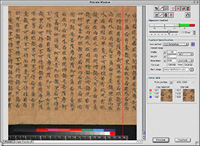
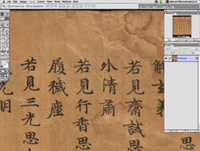
6a-b. The captured image is then checked at 100% (actual size) using Photoshop and, if of sufficient quality, the image is passed for manipulation.

7. Images are manipulated to correct colour balance and produce stitched images which are then resized prior to archiving and uploading to the IDP web site.
Text and photography by Jonathan Jackson with Caroline Smith.
New IDP Website: Buddhism on the Silk Road
The civilizations which flourished along the Silk Road in the first millennium CE were open to cultural and religious influences from both East and West. Many religions, including Christianity, Buddhism, Hinduism, Islam, Zoroastrianism and Manichaeism, gained new followers. But it was Buddhism, travelling the trade routes with pilgrims and merchants, which became the common factor uniting the different peoples of the Silk Road.
The transmission of Buddhism into Central Asia began in earnest with the missionaries of King Ashoka's reign in the third century BCE. By the first century CE, Buddhism was well established in Bactria and Gandhara, and patronised by the Kushana Empire which ruled these areas. As the Empire's sphere of influence moved eastward along the Silk Road, so did Buddhism. Some Buddhist travellers took this route all the way to China.
Most of the other peoples established in Central Asia also adopted Buddhism, to a greater or lesser extent, during the first millennium CE. In the first centuries the Kucheans and Sogdians were influenced by Buddhism, and the Kucheans in particular assisted in its spread eastwards towards China. As their empire expanded into Central Asia in the seventh century, the Tibetans also came into contact with Central Asian Buddhism. Towards the end of this period, the Uighur Turks moved into the area once occupied by the Kucheans and converted to Buddhism. Finally, in the tenth century, the empire of the Tanguts expanded to take in the eastern end of the Silk Road, and the Tanguts became the last of the Buddhists of the Silk Road.
Gradually Chinese power in Central Asia declined and the Mongolian and Turkic influence increased. This promoted the spread of Islam and the decline of Buddhism, which led to its eventual disappearance from Central Asia. With the fall of the Tangut empire to Chinggis Khan in 1227, Buddhism all but disappeared from the Silk Road.
A new website within the IDP site explores the characteristics of these different forms of Buddhism and the connections between them. The website contains images of wall-paintings, manuscripts and other objects from the Silk Road. It includes pages on the Buddhism of the Kushana empire, and the Tibetan, Chinese and Khotanese forms of Buddhism which flourished in Dunhuang and other Silk Road sites, illustrated with maps and timelines.
Sam van Schaik
Conferences
Sir Aurel Stein and Central Asia
British Museum Study Day
London, UK
23 March 2002
This study day, the seventh in the BM's Central Asia series, is devoted to Sir Aurel Stein, and celebrates the completion of the three year UK-Hungarian project to catalogue the collections of Sir Aurel Stein in the Library of the Hungarian Academy of Sciences, Budapest. The speakers will consider Stein from various perspectives in the context of his own lifetime: as a Hungarian (Eva Apor, Agnes Kelecsenyi), as a photographer (John Falconer), as an archaeologist in the North-West Frontier (Elizabeth Errington), as an archaeological explorer in Iran (Vesta Curtis), as an expedition organizer in China (Shareen Blair Brysac), as a writer (Lilla Russell-Smith), and as a public figure in Britain (Helen Wang). Annabel Walker, Stein's biographer, will also speak.
The study day will take place in the British Museum's BP Lecture Theatre, on Saturday 23 March 2002, 10.00 - 16.30.
To book:
The British Museum Box Office (+44 (0)20-7323-8181).
For further details:
Helen Wang
hwang@thebritishmuseum.ac.uk
Eurasian Steppes in Prehistory and the Middle Ages
The State Hermitage Museum St. Petersburg, Russia
March 2002
This conference commemorates the centenary of the birth of the Academician Mikhael Graiznov. Abstracts of 1500 words are required by 1 November.
For details contact:
M. N. Pshenitsyna
Institute of the History of Material Culture
Dvortsovaya naberezhnaya 18
St. Petersburg 191186
Russia
Fax: +7 812 311 6271
Email:nikbok@infopro.spu.su OR admin@archae.ru
The Ninth Annual Central Eurasian Conference
Indiana University
Bloomington, Indiana, USA
13 April 2002
Central Eurasia is defined, for the purpose of this conference, as the vast area including or corresponding to present-day Mongolia, Western China (Xinjiang), Tibet, Central Asia (Uzbekistan, Kazakhstan, Turkmenistan, Kyrgyzstan, Tajikistan, as well as the historic regions of Khorasan and northern Afghanistan), Azerbaijan, Turkey, Hungary, Estonia, Finland, and other regions which include Finno-Ugric peoples.
For details contact:
The Ninth Annual Central Eurasian Studies Conference
Goodbody Hall 157, Indiana University
1011 East Third Street
Bloomington, IN 47405-7005, USA
Fax: +1 812 855-7500
Tel: +1 812 855-9510
Email:ACES@indiana.edu
Information about the conference will be periodically updated on the ACES website:
http://php.indiana.edu/~aces/
Silk Road Art and Culture
The 6th Asian Studies Conference Japan
Sophia University
Ichigaya Campus
Tokyo, Japan
22-23 June, 2002
For details contact:
Dr. Zsuzsanna Gulacsi
Department of Comparative Culture
Sophia University, Ichigaya Campus
4 Yonban-cho, Chiyoda-ku
Tokyo 102-0081, Japan
Tel: (81) (3) 3238-4039
Fax: (81) (3) 3238-4076
Email: zgulacsi@sophia.ac.jp
http://www.meijigakuin.ac.jp/~kokusai/ascj/
Turfan Revisited: The First Century of Research Into the Arts and Cultures of the Silk Road
Berlin, Germany
8-15 September, 2002
This conference will conincide with a major international exhibition at the Museum of Indian Art in Berlin-Dahlem.
For details contact:
Professor Dr Werner Sundermann
Akademienvorhaben Turfanforschung Berlin-Brandenburgishce
Akademie der Wissenschaften
Unter den Linden 6
D-10117 Berlin
Germany
Tel: +49 30 20370 472
Fax: +49 30 20370 467
Email: sundermann@bbaw.de
Conservation of Ancient Sites on the Silk Road: 2nd International Conference on the Conservation of Grotto Sites
Dunhuang, Gansu Province, China
August 25-29, 2003
For details contact:
Kathleen Louw
The Getty Conservation Institute
1200 Getty Center Drive, Suite 700
Los Angeles, CA 90049, USA
Tel: 1-310-440 6216
Email: klouw@getty.edu
http://www.getty.edu/conservation/
More on Stein
Exhibition
Photographs by Sir Aurel Stein
A small exhibition of photographs taken by Sir Aurel Stein will be on display in the British Museum Clore Education Centre from 1 March - 8 April 2002.
Dash Website
Following the popular response to the article on Stein's dogs, Dash 1-7 in the previous newsletter, Rachel Roberts of IDP has now created a web site with photographs and information on the intrepeid canine explorers.
Publications
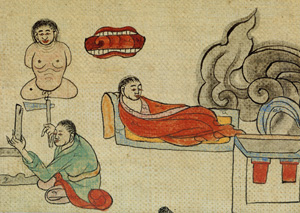
Tibetan Elemental Divination Paintings
Illuminated Manuscripts from The White Beryl of Sangs-rgyas rGya-mtsho
Gyurme Dorje (commentary and translation)
Hardback, 438 pages, 450 x 320mm,
John Eskanazi in association with Sam Fogg, London 2001
This publication represents a landmark in both Tibetan studies and the art of bookmaking. It presents for the first time two magnificent eighteenth-century manuscripts illuminating in exquisite detail the essential but little-known practices of elemental divination as described in The White Beryl, an important seventeenth-century treatise. Accompanying the images is a detailed summary of the White Beryl text, an extensive commentary, and the first English translation of a related text known as Moonbeams.
For details and to order see:
(UK, £345) http://www.wisdom-books.com/ProductDetail.asp?CatNumber=8575
(USA, $495) http://www.shambhala.com/beryl/index.cfm
Bulletin of the Asia Institute 12 published in honor of Paul Bernard.
This volume, and volume 11, are priced at $65 plus $10 shipping, but for a short time, volumes 5-10 are greatly reduced to $25 each plus shipping.
For contents see:
http://www.bulletinasiainstitute.org.
Order from:
3287 Bradway Blvd.,
Bloomfield Hills, MI 48301, USA
Tel: + 1 248-647-7917
Fax: + 1 248-647-9223
Email:BAI34@aol.com
From Nisa to Niya:
New Discoveries and Studies in Central and Inner Asian Art and Archaeology
Madhuvanti Ghose, Lilla Russell-Smith, Burzine Waghmar (edd.). Saffron Books,
London 2002
This is a collection of papers from the very successful London lecture series run by the Circle of Inner Asian Art and Archaeology. Contributions include:
Christoph Baumer on 'New Discoveries in the Taklamakan Desert'
Philip Denwood on 'Tibetan Arts and the Tibetan "Dark Age", AD 842 - 996'
Marilyn Grindley on 'Yulin Cave 39 and the Role of Uighur Patronage in the Origin and Transmission of the Theme of Guanyin with Luohans'
Ksenia Kepping on 'The Guanyin Icon: Chingghis Khan's Last Campaign'
and many others.
For details and to order see:http://www.eapgroup.com/saffron1.htm
Manichaean Art in Berlin CollectionsZsuzsanna Gulasci
283 pp., 210 x 297 mm
Brepols, Turnhout 2001.
HB, ISBN 2-503-50649-6, 145 Euro.
For details and to order see:
http://www.Brepols.net
For further works on Manichaean studies see:
http://www.guoxue.com/study/monijiao/monijiao_ml2.htm
Fieldwork Opportunities
The Center for the Study of Eurasian Nomads is offering two exciting fieldwork Opportunities for Summer 2002 in Mongolia and Southern Russia:
2002 Desert-Steppe Zone of the Middle Gobi Province, Mongolia
http://csen.org/Baga_Gazaryn_Chuluu_Survey_2002/2002_BGC_Index.html
2002 Chastiye Kurgany Excavations in the southern Don Region, north of the Black Sea, Russia
http://csen.org/Chastiye_Kurgany_(all_files)/2002_Chastiye_FWO/2002_Chastiye_Kurgan_Index.html
For questions contact:jkimball@csen.org
The 2001 Chastiye Kurgany Excavations Report, with illustrations and map, is also posted on the CSEN Website at:
http://csen.org/Chastiye_Kurgany_(all_files)/2001_Chastiye_Report/2001_Chastiye_Report.htm
Project News
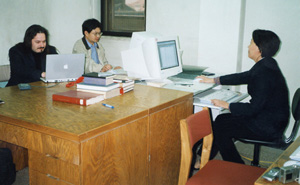
Further to the notice in IDP News 18, work has started on digitizing the National Library of China (NLC) Dunhuang manuscript collection. Phase One have generously made a loan of a Powerphase digital camera back and the camera set-up is now located in the same room as the cataloguers, Mr Lin Shitian and Ms Wang Ziyi (see left with Mark Mitchenall, the database programmer).
Colin Chinnery and Caroline Smith of IDP went to China in December 2001 to train the NLC photographer on the use of the digital camera back according to the guidelines set out in the IDP documents on Procedures and Standards (see pp. 4-5). The training was carried out at Peking University and thanks are owing to them for their cooperation and assistance. Thanks are also due to Eastime, distributers of the digital camera back in China, for their assistance on purchasing photographic equipment and to the Sino-British Fellowship Trust (SBFT) for their continued support of the NLC project. SBFT have recently agreed to increase their annual funding for this project and we are most grateful to them for this.
In order to keep Chinese scholars and institutions better informed of IDP's activities in China, IDP will start producing a newsheet in Chinese for distribution in China from 2002. The IDP website will be relaunched in late 2002 with a choice of Chinese or English interfaces, much improved search facilities, more information, and access to manuscripts from both the British Library and NLC collections.
Tibetan Manuscripts from Dunhuang
Under a three year grant under the Arts and Humanities Research Board Resource Enhancement Scheme, work will start next year on the cataloguing and digitisation of the Tibetan manuscripts from Dunhuang held in the British Library. The grant is designed is designed to fund a collaborative Tibetological project between SOAS and the British Library, Oriental and India Office Collections.
The British Library Dunhuang Tibetica comprise approximately 2000 documents, among the earliest examples of Tibetan language material, and cover religion, history, administration, medicine and personal communications. Since Dunhuang was governed by Tibetan authorities for over 80 years from the mid-eighth century, they are a key source for our understanding of the political, historical and religious developments that shaped the culture and society of dynastic Tibet.
Project Aims
At present, the British Library Dunhuang Tibetan manuscripts are only partially accessible. By the end of this project, scholars world-wide will have free access to high-quality colour facsimiles of the corpus with accompanying catalogue descriptions and other scholarly information. This will be linked to other digital resources and feature greatly enhanced documentation for the tantric documents in the collection.
The principal aim of the project, therefore, is to develop and to promote universal access to the Stein Tibetica by providing an interactive, networked digital edition.
The materials will be available on the www to allow database query and report generation through existing infrastructures created and hosted by IDP. Development of the existing facilities, aimed at enhancing current levels of interactivity, will enable scholars to add their own research to the resource. In short, the project is designed to give free and unfettered digital access to one of the most important collections of early Tibetan documents, hitherto confined to the eyes of a handful of specialists.
Visitors
Yang Baoyu from the Institute of History, Chinese Academy of Social Sciences (CASS), completed a three month visit to the British Library in late November funded under the British Academy CASS exchange scheme. Her primary aim was to complete work on her index to the 14 volumes of facsimiles of non-Buddhist manuscripts in the British Library collection. In addition, she did research on her own speciality of the development of printing and the book format in China.
Colin Chinnery gave a paper at the conference 'International Dunhuang Studies in the 21st Century' held in November at Chung Cheng University, Taiwan. In late November he give a presentation at Duke University, USA and then travelled on to attend an ECAI training session on GIS tools before attending their annual conference in Mexico at which he gave a presentation to show a new prototype of a map interface for IDP. IDP at the National Library of China.
